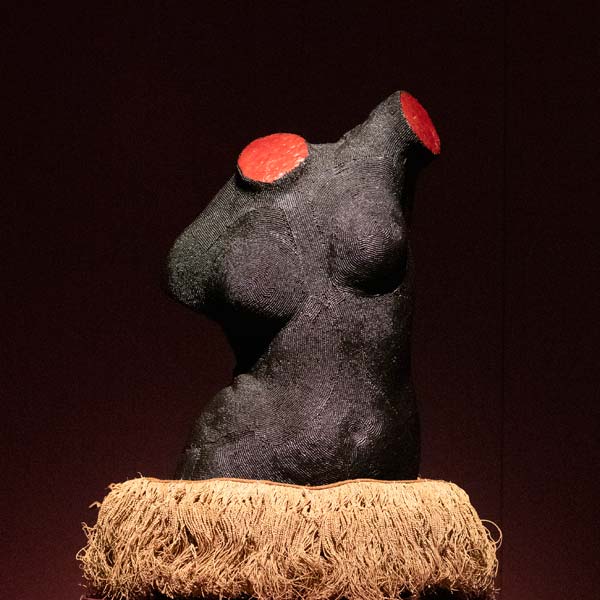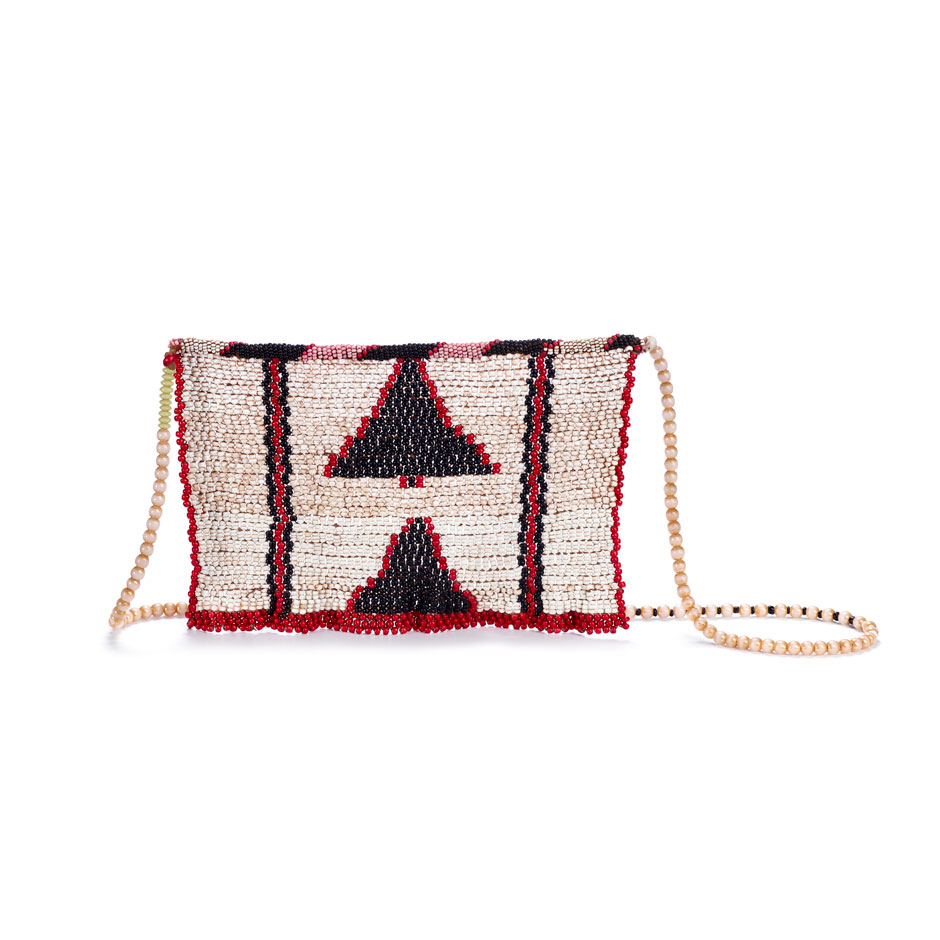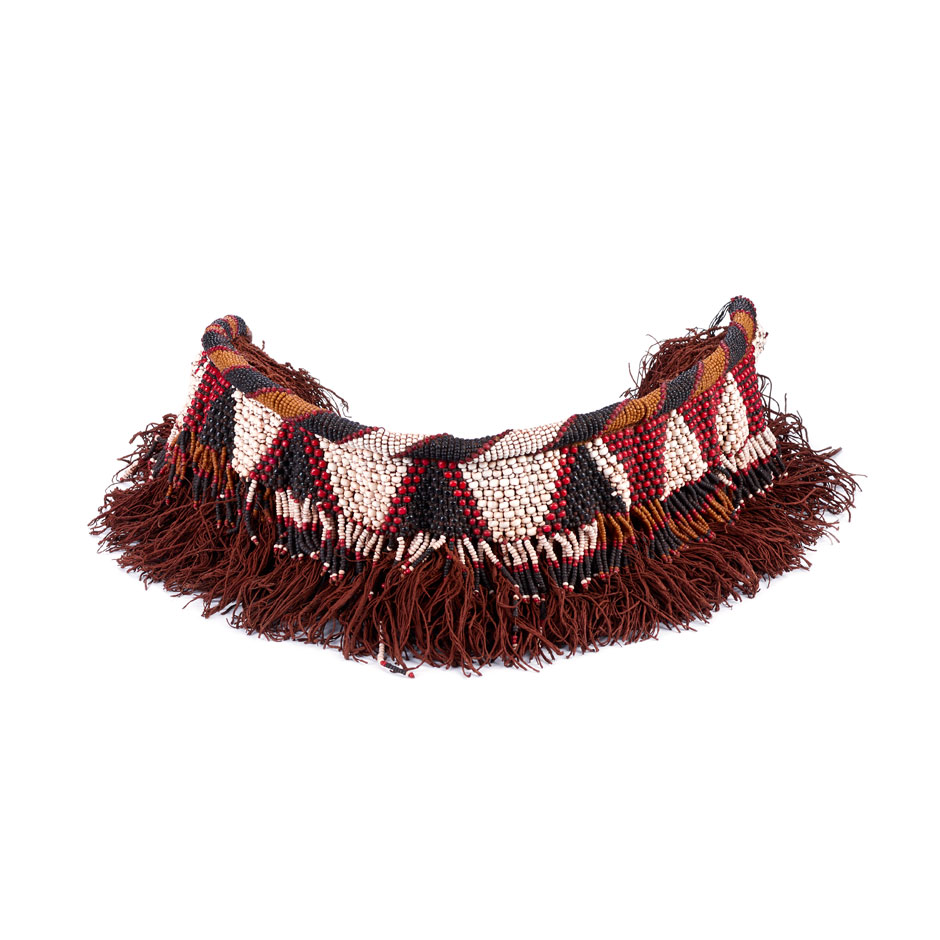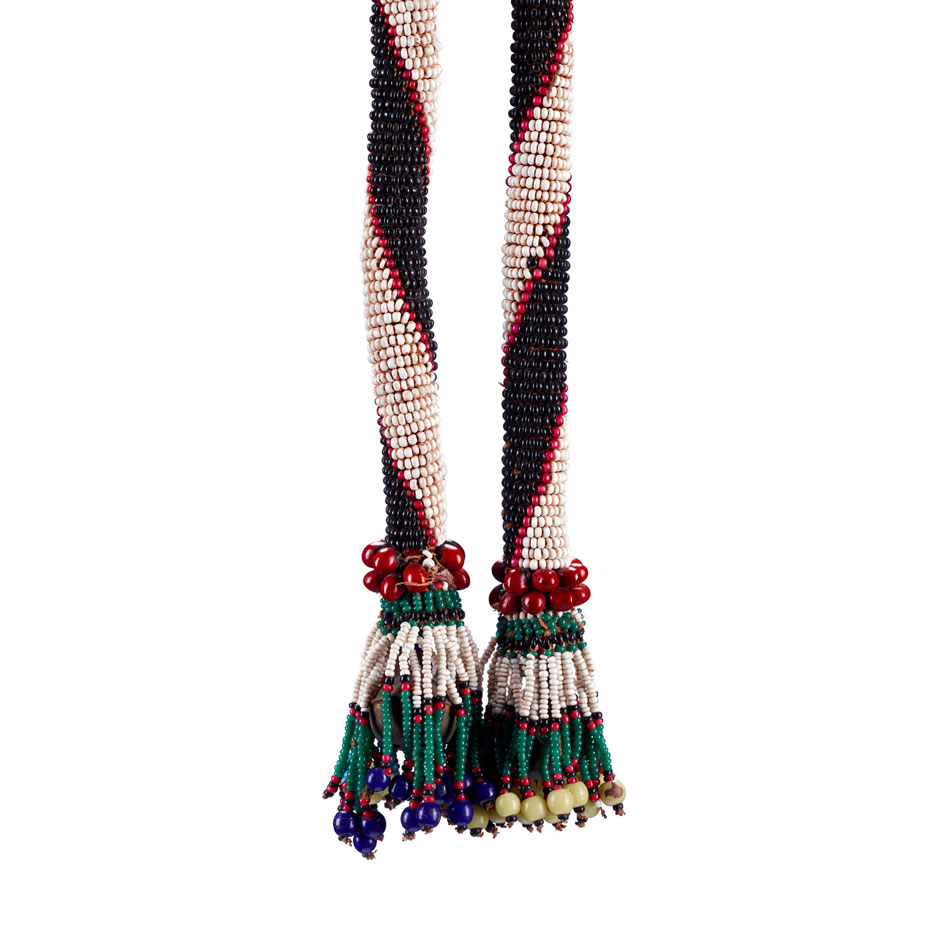DISMEMBERED – REMEMBERED

A multivocal rehumanization space, this installation highlights women’s heritages, the heritages of invisibilized women. The title evokes two sides of a cultural heritage uprooted from its original ecosystem. DISMEMBERED stresses memorial fragmentation, as well as the physical and symbolic violence of removing intimate éléments of women’s bodies; REMEMBERED focuses on the memory to be reconstructed, the link to be restored and the passing down to be done.
The contemporary creations of Lafalaise Dion and Beya Gille Gacha dialogue here with old works, some of whose creators, Nkamoheng and Tlalane, have been identified, which is rare in colonial collections as most of them are anonymous. The visit takes place to the rhythm of Paloma Lukumbi’s sound poem, which retrieves from the archival abyss the rare names of the women to whom the fine garments exhibited belonged.
The entire Southern African Bertrand collection, of which only a tiny sample is presented here, can be consulted on the MEG's online catalogue of collections.
https://www.ville-ge.ch/meg/sql/en/musinfo00.php?what=Bertrand&dpt=ETHAF&debut=0&bool=AND
https://www.ville-ge.ch/meg/sql/en/musinfo00.php?what=Bertrand&dpt=ETHAF&debut=0&bool=AND
Bansoa Sigam

Bansoa Sigam
Bansoa Sigam is a Swiss curator and researcher of Cameroonian descent specializing in African arts and heritages. In the academic context, she plays a significant role in the enrichment of research on matrimonies and advocates the recognition of African women’s heritages often rendered invisible. In her work as a curator she explores both their historic and contemporary traces and endeavours to bring to light the contributions made by artists on the continent and in the diaspora.
DISMEMBERED
Lithethana (thethana in the singular form) are fine garments which embody the violence entailed in the captation of elements of women’s intimacy and identity in southern Africa at the turn of the 20th century. These fine items of clothing, whose confection necessitates the involvement of several women, are part of the construction of both the individual and collective identity of young girls, particularly those of the Lesotho culture. During initiations, rows are added, fibres dyed, and the clothing made sacred. Traditionally symbiotically linked to the body, the garments evolve as the status and physical size of the wearers change. They are central to a system co-creating a community and intergenerational transmission link.
Divesting girls and women of their lithethana in the colonial period – this act of removal from bodies, done in conditions seldom documented, can be seen through the prism of dismemberment: an action consisting in separating parts of the body, taking it to pieces and immobilizing it.
Bansoa Sigam

Venus Nigra
Beya Gille Gacha. 2017
Wax, glass beads
Loan from the artist
This bust was created in the context of the “dismemberment” series evoking the resistance of women of shattered destinies, divested of the tools necessary for self-accomplishment, the arms used to shape, and the capacity to progress, the legs making it possible to walk. Immobile, this bust nonetheless embodies dignity, grace and strength in the face of adversity. B. Sigam

Beya Gille Gacha
Beya Gille Gacha is a pluridisciplinary artist, born on December 8, 1990 in Paris, to a Cameroonian mother and a French father. She entered the Ecole du Louvre in 2011, however Beya Gille Gacha is a self-taught artist who conceives her artistic practice as an engagement in an intersectional perspective; thus she creates two collectives including DES GOSSES, in 2016, with artists Rakajoo and Neals Niat, which questions the lack of representation of young Afro-French artists with singular paths.
In 2017, she joined the Coalition of Artists for the General History of Africa at UNESCO.
In 2024, her work will again be featured in the IN de Biennale de Dakar, this time in the Curator Choice exhibition entitled "On s'arrêtera quand la terre rugira", and at the Beelden Op de Berg Sculpture Biennial, in Wageningen, Netherlands.
Photograph © Lorenzo Piano
To go further [PDF 0.3 Mo]

Thethana
Unknown wearer and creator(s)
South Africa, Lesotho. Attributed origin: Sesotho
Late 19th early – 20th century
Tsikitlane (Gazania serrulata) plant fibres
Alice and Alfred Bertrand Collection
MEG Inv. ETHAF 018131
Archives of the time indicate that a thethana like this was not worn alone but covered by other clothes such as a blanket or skirt. The large number of these pieces in several missionary collections evidences a period of intense societal changes in southern Africa.
Among the ten specimens presented here, only the name of Mery-Jane Mohlaka is known, the other wearers and creators remain, as often, anonymous. B. Sigam
CONNECTING
Immerging ourselves in this installation, we discover a beaded ngwana sehô figurine beneath a protective headdress of cowrie shells. It represents a memorial trace of the separation undergone by the woman for whom it was intended. Ngwana means «child» in the Sesotho language, and the ngwana sehô is an anthropomorphic representation to be cherished as her child. Nearly 200 years old and so contemporaneously and vividly bright, this vector of fertility, abundance and heritage is a container of intentions to conceive life. Its presence here marks the lack created by the breaking of this maternal link on its captation during the colonial period.
Handed down from generation to generation in the family of the missionary who carried it off in the mid 19th century, it only entered the Museum in 2021. It is both the most recent and the oldest piece in the installation. It represents just as much the memory of rupture as the hope of restoring the link with its original womb.
Bansoa Sigam

Mamy Watta
Lafalaise Dion. 2019
Lafalaise Dion studio. Ivory Coast. Headdress of 476 cowrie shells. Monetaria Moneta shells, fishing line, beads, terracotta
Loan from the artist
Mamy Watta, the water mother, embodies the divine force governing oceans, an inexhaustible source of life, power and fertility. From Lafalaise Dion's first collection, this creation painstakingly assembled by hand is made up of cowries, a shell as resistant as it is delicate, a symbol of ancestry, sacredness and abundance. By covering it with fringe, Mamy Watta is linked to the story of ngwana sehô, symbolizing the force of reconnection with one's maternal roots. B. Sigam
Bansoa Sigam

Lafalaise Dion
Lafalaise Dion is the brainchild of Dion Dewand Marcia Lafalaise, an African/Dan creative soul born and raised in Côte d'Ivoire. Drawing inspiration from the vibrant tapestry of her homeland, particularly her upbringing in Man, the city of 18 mountains, Lafalaise Dion is steeped in a culture that fosters a profound appreciation for life, love, craftsmanship, storytelling, indigenous cultures, traditions, transmission, healing, and self-love.
With a compelling vision driving her, Lafalaise Dion aspires to serve as a beacon of cultural celebration and empowerment. Dion envisions a world where craftsmanship, spirituality, and self-love intertwine seamlessly, creating a space where individuals can reconnect with their heritage and embrace their unique identities. This visionary outlook permeates every facet of Lafalaise Dion's journey, from its inception to its profound impact on communities across Africa and beyond.
To go further [PDF 0.3 Mo]
Mosebetsi Pheko, « Healing work* »
Paloma Lukumbi aka D. Thoughts. 2023
Credits: D. Thoughts (voice and texts, shekere, water drums; Kwanza River, Angola) accompanied by Adama Faye (tama, djembe, shekere, percussion instruments). Recordings: Brazzaville Records, Geneva. Production: Laurent Vonlanthen accompanied by Lucas Orias, Kitchen Studio, Geneva.
Length: 7 min 19 s
*translated from Sesotho after Mamaseko by Thabile Makue
Draped in the names of Befa, Mamotumi, Lila Lioto, Ramaleko, Mofieli, Mery-Jane Mohlaka, Liemiso, Tlalane, Maghirha, Emily Bangoane, Nkamoheng, Matcha, Somazembe and Ramabotsese, this sound composition invites us to commune with women whose presence makes epistemically silenced genealogies ring out. In this contemplative space, I commemorate these women, intermingling notably the MEG's archives, voices and sound landscapes.
Draped in the names of Befa, Mamotumi, Lila Lioto, Ramaleko, Mofieli, Mery-Jane Mohlaka, Liemiso, Tlalane, Maghirha, Emily Bangoane, Nkamoheng, Matcha, Somazembe and Ramabotsese, this sound composition invites us to commune with women whose presence makes epistemically silenced genealogies ring out. In this contemplative space, I commemorate these women, intermingling notably the MEG's archives, voices and sound landscapes.
Paloma Lukumbi

Paloma Lukumbi
Paloma Lukumbi is from the Bakongo region of Uige (now part of Angola) and Basque. With a passion for stories of all kinds, she obtained a Bachelor's degree in English Language and Literature and General Linguistics in 2010. Throughout this period, her focus has been on post-colonial, Afro-American and queer literature.
As a sonic poet, she honed her artistic practice through the development of a genre she calls the "docu-poem," combining voice and words. It was in this context that she travelled across the United States, taking a particular interest in the textures of black women's voices as a medium of transmission, as captured in black music and literature. Later, it was her encounter with the author Essex Hemphill and her book Ceremonies: Prose and Poetry that her practice would take a completely different turn - notably around questions of the intimate and the ceremonial (from an epistemic but above all a liminal point of view). (Hemphill, Essex. Ceremonies: Prose and Poetry. A Plume Book (Penguins Book): New York, 1992).
She will complete her MA in English Literature in 2019, simultaneously presenting her first book of poems and a visual project called "Melanated" Futurism and Sonic Voices. (Project combining my poems performed by myself and Afro-descendant artists; produced by Samuel Chispa, Geneva (2019)). Today, she works on a variety of creative projects, occasionally publishing/translating, but also in cultural mediation.
REMEMBERED
The partial piecing together of memories from a few fragments of material and immaterial archives is only a beginning. This visibilization, admittedly incomplete, aims at filling the excess historical void, repairing the broken memory and catalyzing transcontinental reconstruction and synergies. The installation stresses the necessity of remembering that every piece of finery presented here belonged to a woman who had often worn and sometimes created it, alone or in a group. The creators used cowries or beads, mophete seeds or tsikitlane flowers and made these plant elements into sacred adornments.
Outside the ecosystem where these ornaments and clothes were used to reveal and emphasize the wearer’s identity within the collective, it is admittedly difficult to grasp all their meaning. It is however possible to throw light on and remember the women evidenced by these adornments and creations.
Bansoa Sigam

















